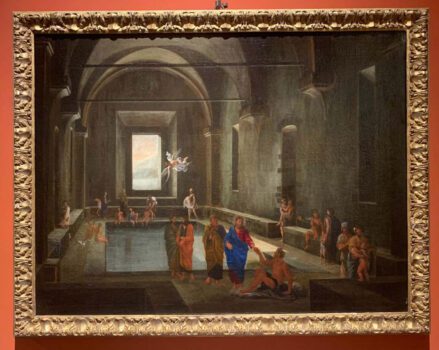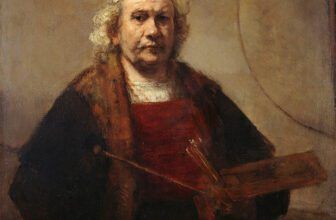Giovanni Lanfranco’s Famous Baroque Paintings
Giovanni Lanfranco (1582–1647) was a central figure of the Italian Baroque movement, a painter known for his dramatic, illusionistic frescoes and his ability to blend spiritual power with theatrical grandeur. Although somewhat overshadowed by his more famous contemporaries like Pietro da Cortona and Guercino, Lanfranco left behind a body of work that is remarkable for its emotional intensity, technical mastery, and innovative compositions. His ceiling frescoes, in particular, are some of the finest examples of quadratura painting in the Baroque era, blurring the lines between architecture and painted illusion.
This is the story of Giovanni Lanfranco: his life, his art, his most celebrated paintings, and the legacy he left behind.
Early Life and Artistic Formation
Born in Parma, Italy, in 1582, Giovanni Lanfranco was raised in a region steeped in Renaissance traditions. He showed artistic talent from an early age and was apprenticed to Agostino Carracci, one of the founders of the influential Bolognese School. Lanfranco’s formative years were spent absorbing the Carracci emphasis on naturalism and anatomical precision, combined with the grandeur of High Renaissance masters like Raphael and Correggio.
Lanfranco later moved to Rome, where he entered the competitive art world dominated by the likes of Caravaggio, Annibale Carracci, and Domenichino. Here, he matured as a painter and gradually developed his own distinct style, one that blended the dynamic energy of the Baroque with an ethereal, almost celestial spirituality.
What Is Giovanni Lanfranco Known For?
Lanfranco is best known for his monumental frescoes, particularly his illusionistic ceiling paintings. These works helped pioneer the Baroque style of quadratura, a technique that uses painted architectural elements to extend the real architecture into an illusory, often heavenly space.
He was a master of di sotto in sù (“from below upward”) perspective, creating awe-inspiring visions of saints, angels, and biblical scenes that seem to break through the ceilings of churches and vaults into the heavens.
His ability to combine emotion, movement, and spiritual transcendence in a single composition made him one of the leading figures in Baroque art, influencing countless artists throughout Italy and beyond.
Giovanni Lanfranco’s Most Famous Paintings
Lanfranco created many works throughout his life, but several stand out as his masterpieces, recognized both for their historical importance and artistic brilliance.
1. The Assumption of the Virgin (1625–1627)
Location: Dome of Sant’Andrea della Valle, Rome
This is perhaps Lanfranco’s most celebrated and most ambitious work. Commissioned for the dome of the Church of Sant’Andrea della Valle in Rome, this fresco showcases the Assumption of the Virgin Mary, surrounded by angels and saints, ascending into a sky that seems to dissolve the physical limits of the dome.
It’s a stunning example of Baroque illusionism. Lanfranco’s use of perspective and foreshortening gives the illusion that the viewer is looking directly into the heavens. The figures are arranged in a spiral movement that draws the eye upward, creating a profound sense of movement and divine elevation.
This fresco put Lanfranco on the map as one of the masters of Roman Baroque painting and helped define the visual vocabulary of the period.
2. Glory of St. Cecilia (c. 1612–1614)
Location: Chapel of Saint Cecilia, San Luigi dei Francesi, Rome
This fresco showcases Lanfranco’s growing mastery of light and space. Painted in the chapel of San Luigi dei Francesi, where Caravaggio also left his mark, this ceiling represents St. Cecilia in a heavenly vision surrounded by angels and musical instruments. The golden light and musical elements make the painting vibrant, spiritual, and emotionally resonant.
3. The Coronation of the Virgin
Location: Naples, Certosa di San Martino
This composition is another highlight of Lanfranco’s career. Painted during his time in Naples, it shows the Virgin Mary being crowned by Christ in a celestial scene surrounded by angels and cherubs. The combination of soft color palettes and luminous lighting demonstrates his command of luminosity and softness, key Baroque traits.
4. Ecstasy of St. Margaret of Cortona
Location: Palazzo Pitti, Florence
This canvas captures the moment of mystical union between St. Margaret and the divine. Lanfranco’s handling of the subject is emotionally charged, echoing the Counter-Reformation ideals of direct emotional engagement with the divine.
The Story of Giovanni Lanfranco’s Career and Travels
Lanfranco’s career can be divided into several phases, marked by his travels and stylistic evolutions.
In Rome
In Rome, Lanfranco worked under Annibale Carracci and later began to receive his own commissions. His work in Sant’Andrea della Valle marked his emergence as a significant figure in the Roman art world. Here, he was in direct competition with Domenichino, another student of the Carracci. The rivalry between the two was intense, especially as they competed for prestigious religious commissions.
In Naples
In 1634, Lanfranco moved to Naples, a city that was undergoing an artistic renaissance. There, he produced some of his most celebrated altarpieces and frescoes, including work in the Certosa di San Martino and Gesù Nuovo.
Naples offered Lanfranco a new environment to express his mature style, more luminous, colorful, and grand. His influence in Naples was significant, and he helped usher in the Neapolitan Baroque, inspiring artists such as Luca Giordano.
Final Years
Lanfranco returned to Rome toward the end of his life, where he was commissioned to paint the Blessed Sacrament Chapel in St. Peter’s Basilica, a significant recognition of his stature. He died in 1647, leaving behind a career filled with spiritual richness and artistic innovation.
What Is the Most Expensive Giovanni Lanfranco Painting?
Lanfranco’s frescoes are immovable masterpieces, embedded in the ceilings and walls of churches across Italy. However, his easel paintings and sketches occasionally come up for auction and can fetch high prices.
The most expensive Giovanni Lanfranco painting sold at auction is “The Martyrdom of Saint Margaret”, which sold for over $1 million in a Sotheby’s auction in the early 2000s. Though prices fluctuate, and he remains relatively undervalued compared to other Baroque masters, his works are increasingly sought after, especially as scholars and collectors revisit his contributions to 17th-century art.
How Many Paintings Did Giovanni Lanfranco Create?
While the exact number of Lanfranco’s works is hard to determine, especially considering the many collaborative and workshop pieces, it is estimated that he created:
Dozens of large-scale fresco cycles in Rome and Naples
Approximately 50–70 oil paintings, including altarpieces and easel paintings
Numerous drawings and preparatory sketches, many held in major museum collections like the Louvre and the British Museum
His body of work is extensive and diverse, ranging from monumental religious compositions to more intimate devotional images.
Where Are Giovanni Lanfranco’s Paintings Located?
Lanfranco’s works are scattered across Italy and the world. The majority remain in situ, meaning they are painted directly into the architecture of churches and chapels. Here are some major locations where his works can be seen:
Rome:
Sant’Andrea della Valle – Assumption of the Virgin (dome fresco)
San Luigi dei Francesi – Glory of St. Cecilia
St. Peter’s Basilica – Chapel of the Blessed Sacrament
Palazzo Barberini – Various paintings and sketches
Naples:
Certosa di San Martino – Multiple frescoes
Church of Gesù Nuovo – Vault frescoes
Florence:
Palazzo Pitti – Ecstasy of St. Margaret of Cortona
Museums Around the World:
The Louvre, Paris – Drawings and a few paintings
The British Museum, London – Sketches and studies
Metropolitan Museum of Art, New York – Several oil sketches
Museo di Capodimonte, Naples – Major oil works and studies
What Is Giovanni Lanfranco’s Legacy?
Giovanni Lanfranco’s legacy lies not only in his body of work but also in the path he paved for future generations of artists.
1. Innovator of Illusionistic Painting
Lanfranco advanced the techniques of illusionistic ceiling painting, influencing later Baroque artists like Pietro da Cortona, Andrea Pozzo, and Giovanni Battista Gaulli. His work directly contributed to the visual language of the Catholic Counter-Reformation, which emphasized awe-inspiring grandeur to convey religious truths.
2. Bridge Between Carracci and Neapolitan Baroque
His style bridged the idealism of the Carracci school and the theatricality of Neapolitan Baroque painting. He was instrumental in bringing a Roman flavor to Neapolitan art, enriching the cultural exchange between Italy’s artistic centers.
3. Underappreciated Master
Despite his talent and acclaim during his lifetime, Lanfranco was historically overshadowed by contemporaries such as Caravaggio, Domenichino, and Guercino. However, recent scholarship has renewed interest in his contributions, positioning him as a central figure in 17th-century art.
Giovanni Lanfranco may not be as widely recognized today as some of his Baroque contemporaries, but his impact on the development of illusionistic painting and religious art is profound. His frescoes, soaring with divine light and dynamic movement, invite viewers into transcendent spaces that defy earthly limitations.
From the dome of Sant’Andrea della Valle to the chapels of Naples, Lanfranco’s work continues to inspire awe. His ability to merge architecture, theology, and dramatic storytelling into breathtaking compositions makes him one of the great visionaries of Baroque art.
As museums and scholars continue to re-evaluate his oeuvre, Lanfranco’s legacy as a master of visual transcendence is being rightfully restored, ensuring that his divine visions remain part of the art historical canon for generations to come. image/1stdibs.com




